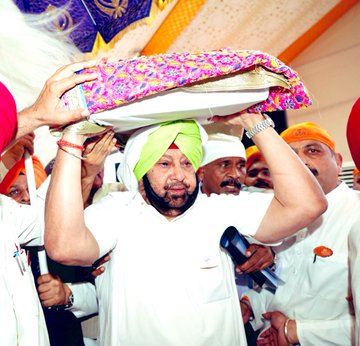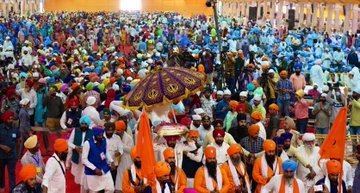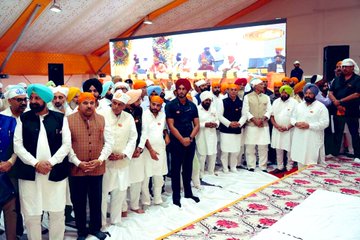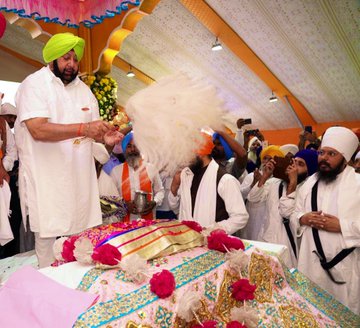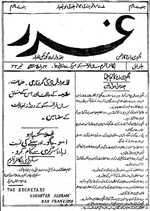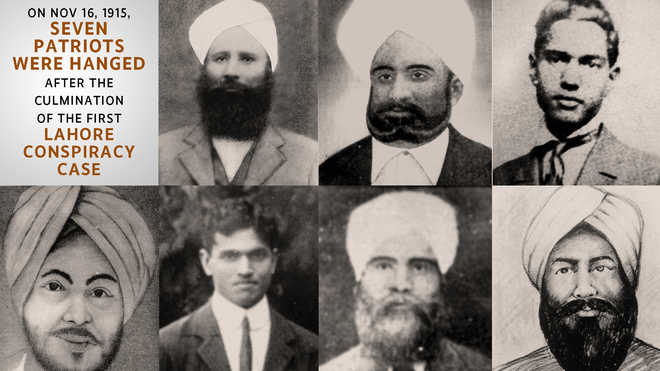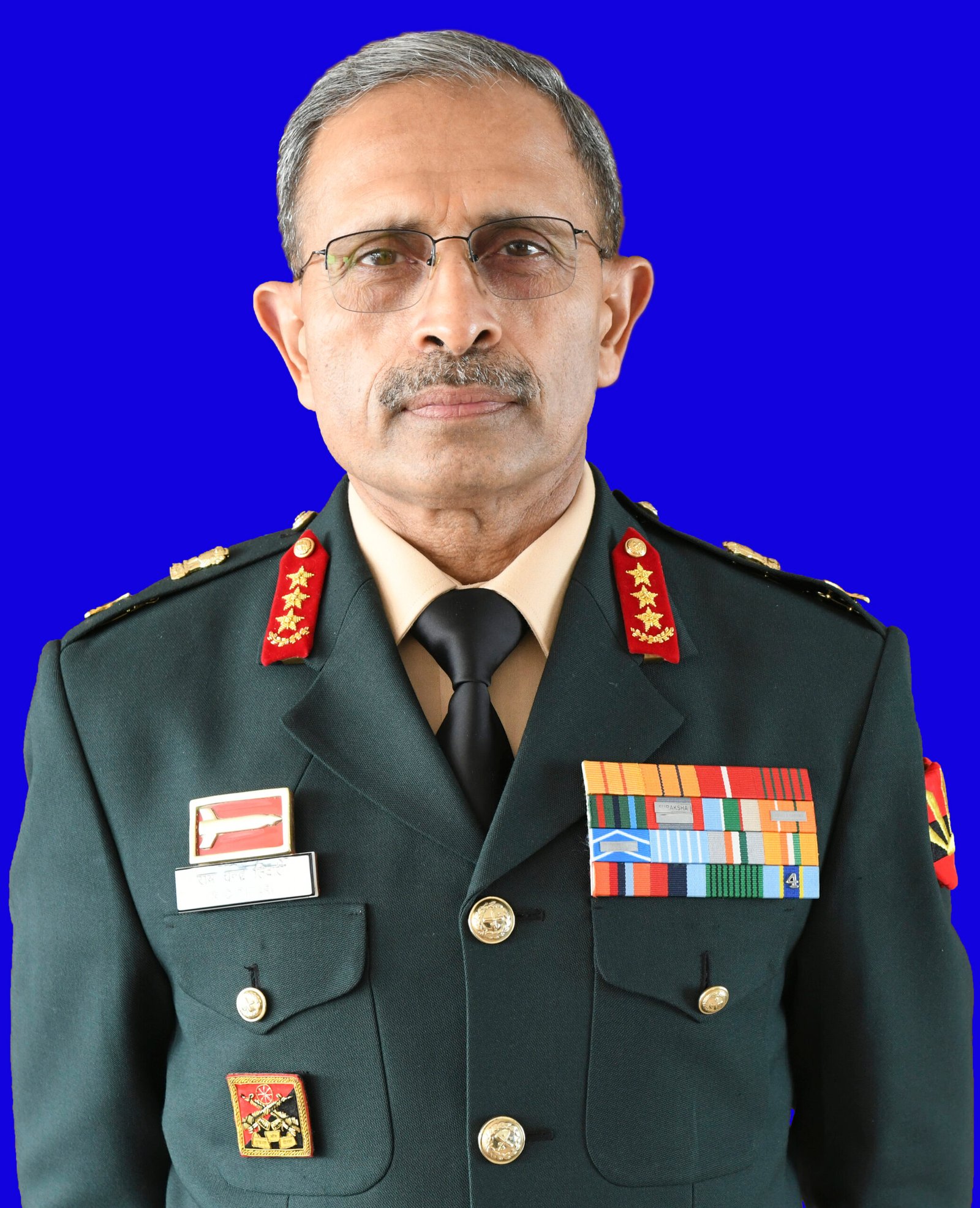Tribune News Service
Sultanpur Lodhi, November 5
Punjab Chief Minister Captain Amarinder Singh on Tuesday inaugurated the week-long main celebrations of the 550th Parkash Purb at the historic Sultanpur Lodhi.
At the event, which is held to mark the 550th birthday anniversary of the first Sikh Guru, Guru Nanak, Captain said there should be no “politics” played at the auspicious event—referring to the controversy surrounding the celebrations.
There are two events scheduled at Sultanpur Lodhi to mark the day—one to be held by the state government under Chief Minister Amarinder Singh and the other being organised by the Shiromani Gurdwara Parbandhak Committee.
The chief minister asked people to follow the Guru’s teachings of tolerance and harmony to counter the growing instances religious intolerance in the country. He invited the participants to the main function on November 12, and also to visit the Kartarpur Corridor, which will be inaugurated by Prime Minister Narendra Modi on November 9 at Dera Baba Nanak.
On this occasion, the Captain announced a new administrative complex, and Rs 150 crore ring roads, around the heritage city of Sultanour Lodhi, to enhance its connectivity with other cities. The iconic, Quila Sarai, at present doubling up as the Tehsil administrative office, would be preserved by the state government as heritage building, he said.
Amarinder, along with Cabinet Minister Charnjit Singh Channi, also released four books related with Guru Nanak’s philosophy penned and edited by acclaimed Punjabi writers including Surjit Patar.
The books—Guru Nanak’s ‘Blessed Trail’, ‘Guru Nanak Bani’, Sone Ka Birkh’ (The Golden Tree) and Guru Nanak Dev Ji Life and Relics’—have been printed by the Department of Tourism and Cultural Affairs.
Besides, the Captain inaugurated two exhibitions containing relics, manuscripts and rare books associated with Sri Guru Nanak Dev Ji’s life.
One, put up by the Tourism and Cultural Affairs Department, showcases 53 panels depicting the life of the first Sikh Guru, while the other has been curated by the Punjab Small Industries Export Corporation.
Upgrading and widening of roads, besides construction of new bridges and improvement of hospitals, had been undertaken at a cost of Rs. 235 crores, the Captian pointed out, adding that a Rs. 100 Crores project to develop all 70-odd Pahli Patshahi de Charan Chhoe Prapt Pind as model villages with proper amenities has also been initiated.
The Chief Minister announced that cleaning and lining of the right bank of the Holy Bein had been completed in the Sultanpur Lodhi section at a cost of Rs. 11 crores, in partnership with Sant Seechewal.
The State Government, said Captain Amarinder, had also secured approval from the Centre for its proposal to develop Sultanpur Lodhi as a Heritage Town for Rs. 271 crore on 50:50 sharing basis, and to set up a Centre for Inter-Faith Studies at GNDU Amritsar at a cost of Rs. 175 crores.
It had also proposed establishment of a Pind Babe Nanak Da (Museum in around 75-80 acres of land) at a cost of Rs. 300 crores, he added.
Widening of Sri Guru Nanak Dev Ji Marg from Sultanpur Lodhi to Dera Baba Nanak Road via Beas and Raiyya had been undertaken at a cost of Rs. 102 Crores, the Chief Minister said.
Highlighting the world class arrangements made for pilgrims, the Chief Minister said that a tented city, spread across 277 acres, for 35,000 people had been erected a cost of Rs. 53 Crores, with 2200 temporary toilets and 10 water vending machines, besides 18 parking sites spread over 542 acres to facilitate the devotees.
Special trains, including Prakash Purab Express from Delhi to Sultanpur Lodhi, had also being made operational. Punjab had also made efficient arrangements for running of special buses and mini buses as well as e-rickshaws, free of cost for the devotees in Sultanpur Lodhi, said the Chief Minister.
To mark the historic occasion, the Captain’s government has convened a Special Vidhan Sabha Session on Wednesday, which is to be addressed by Vice President of India M. Venkiah Naidu and former Prime Minister Dr. Manmohan Singh.
A Conference of scholars on peace and amity would also be organised at Chandigarh on November 7th and 8th besides Ik Noor Inter-Faith Conclave on November 9th at Amritsar, to be attended by many personalities including the Dalai Lama.
The Dera Baba Nanak Utsav would attract devotees from around the world from 8th to 11th November, while eminent Punjabis would be honoured at PTU Kapurthala on 10th, he added.
Capt launches week-long function, flags fears on Pak’s corridor moveword of caution Says ISI will use corridor to promote ‘Referendum 2020’, rejects claim that Modi is seeking credit for project



Jatinder Mahal
jatinder@htlive.com
Sultanpur Lodhi : Punjab chief minister Capt Amarinder Singh on Tuesday inaugurated the week-long celebrations of the 550th birth anniversary (Parkash Purb) of Guru Nanak at the historic town of Sultanpur Lodhi, with a word of caution against Pakistan’s move to open the Kartarpur corridor by terming it “suspicious”.
“Its agency Inter-Services Intelligence (ISI) is going to make full use of the corridor to promote pro-Khalistan campaign ‘Referendum 2020’ besides its own agenda. They want the sympathy of the Sikh community to back up ‘2020 Referendum’. Everyone is happy with the religious part but the neighbouring country’s political strategy is different and the situation is worse than before,” he said responding to a question on the sidelines of the inauguration of an exhibition as part of the celebrations.
Earlier also, the CM has blamed Pakistan for helping hardliner Sikh groups to disrupt peace and harmony in Punjab.
Amarinder rejected the claims that Prime Minister Narendra Modi is seeking credit for the Kartarpur corridor saying, “It happened this time that the corridor is opening and he will inaugurate it being the PM. The project was in the pipeline for decades. During my previous term as CM, former prime minister Manmohan Singh had also taken the corridor issue with Pakistan.”
Modi on November 9 will formally inaugurate the Indian side of the corridor that will connect with Gurdwara Darbar Sahib in Kartarpur, Pakistan.
‘Appeals against indulging in politics’
The CM appealed to one and all not to indulge in politics or one-upmanship and commemorate the auspicious event in the spirit of universal brotherhood as propagated by the first Sikh master.
Earlier, he launched the celebrations by performing ‘sewa’ (service) of Saroop of Guru Granth Sahib, the Sikh holy book, before start of ‘Sehaj Path’ jointly organised by the state government, religious organisations and Sant Samaj at the main podium of the function.
He also announced a new administrative complex and ₹150 crore ring road around the heritage city of Sultanpur Lodhi to enhance its connectivity with other cities.
He also announced that iconic Quila Serai to be preserved as heritage building.
He released four books on Guru Nanak’s philosophy penned and edited by acclaimed Punjabi writers, including Surjit Patar. The books ‘Guru Nanak’s Blessed Trail’, ‘Guru Nanak Bani’, ‘Sone Ka Birkh’ (the Golden Tree) and ‘Guru Nanak Dev’s Life and Relics’ have been printed by the state department of tourism and cultural affairs.
Exhibitions on relics, manuscripts
Later, he inaugurated two exhibitions containing relics, manuscripts and rare books associated with Guru Nanak’s life.
The first, put up by the tourism and cultural affairs department, showcases 53 panels depicting the life of the first Guru, while the other is curated by the Punjab Small Industries Export Corporation.
Amarinder said repair and widening of roads and construction of new bridges besides upgrade of hospitals was undertaken at ₹235 crore.
A ₹100 crore project to develop all 70-odd ‘Pehli Patshahi de Charan Chhoe Prapt Pind’ as model villages with all amenities was also initiated, he added.
The state government, the CM said, will convene a special Vidhan Sabha session on Wednesday to be addressed by Vice President M Venkiah Naidu and former Prime Minister Dr Manmohan Singh.
A conference of scholars on peace and amity will also be organised in Chandigarh on November 7 and 8 besides ‘Ik Noor Inter-Faith Conclave’ on November 9 in Amritsar to be attended by distinguished personalities, including the Dalai Lama.
 Women preparing food at a langar in Sultanpur Lodhi. Ht photo
Women preparing food at a langar in Sultanpur Lodhi. Ht photoGagandeep Jassowal
gagandeep@htlive.com
SULTANPUR LODHI : Women from various parts of Punjab besides states like Uttar Pradesh, Delhi, Uttarakhand and Haryana are camping in Sultanpur Lodhi to serve meal at various langars (community kitchens) to lakhs of devotees visiting the town as part of the 550th birth anniversary celebrations of Guru Nanak.
More than 70 large langars are set up here. Also, women from nearby areas are offering sewa (service) from morning till late evening. The langar organisers have arranged transportation service for those coming from nearby villages.
At ‘Bebe Nanaki Langar’, Sandeep Kaur, a resident of Sherpur Sadda village of Kapurthala district, said she along with 10 other women comes at 10am and stays here till evening. “Being from the surrounding area, it is our duty to host the pilgrims in a better way. Secondly, it’s a lifetime opportunity,” she says.
Gurmeet Kaur from Bilaspur town in Uttar Pradesh came with a jatha of 10 women on November 1. “We all belong to Bilaspur. It’s all about devotion to Guru Nanak”, she says. Veer Kaur, 75, who came with five women from Kashipur town in Uttarakhand, says, “It was like dream come true to attend the celebrations and contribute to the same by performing sewa.”
At another langar, Raj Kaur of Ali Kalan village of Kapurthala district says, “I am part of a group of 40 women who are cleaning utensils so that the devotees have not to wait for long.”
Baba Nidhan Singh ‘Hazur Sahib Wale’, who is running the largest langar, said 500 women from various districts of Punjab are offering sewa and are playing a key role in the entire process.











